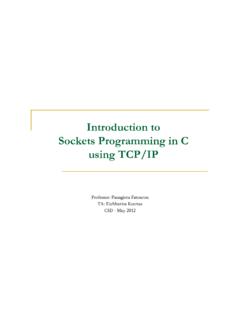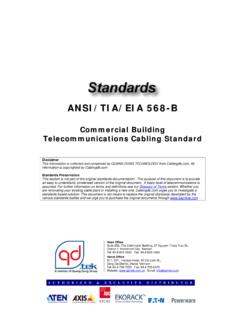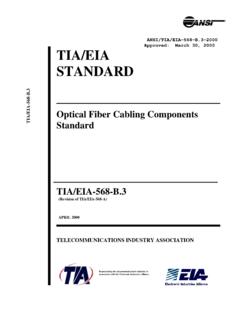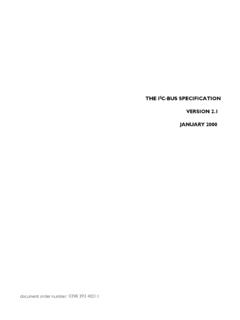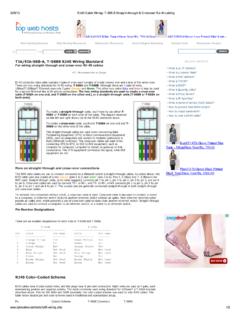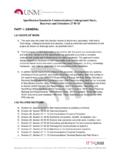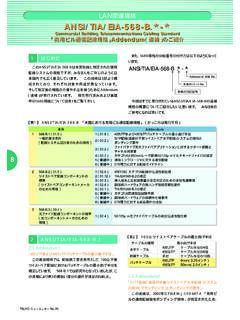Transcription of Cabling Standard - ANSI-TIA-EIA 568 B - Commercial ...
1 ANSI/TIA/EIA 568-B. Commercial Building Telecommunications Cabling Standard Disclaimer This information is collected and composed by QUANG DUNG TECHNOLOGY from All information is copyrighted by Standards Preservation This section is not part of the original standards documentation. The purpose of this document is to provide an easy to understand, condensed version of the original document. A basic level of telecommunications is assumed. For further information on terms and definitions see our Glossary of Terms section. Whether you are renovating your existing cable plant or installing a new one, urges you to investigate a standards based solution. This document is not meant to replace the original standards developed by the various standards bodies and we urge you to purchase the original documents through Head Office Suite 202, The Colonnade Building, 27 Nguyen Trung Truc St., District 1, Hochiminh City, Vietnam Tel: 823-1693 Fax: 823-1665. Hanoi Office A11, 3/Fl., Horizon Hotel, 40 Cat Linh St.
2 , Dong Da District, Hanoi, Vietnam Tel: 736-7055 Fax: 733-2470. Website: Email: A U T H O R I Z E D & E X C L U S I V E D I S T R I B U T O R. ANSI/TIA/EIA 568-B Commercial Building Telecommunications Cabling Standard Table of Contents ANSI/ Commercial BUILDING. TELECOMMUNICATIONS Cabling Standard . General Requirements ANSI/ 100 OHM TWISTED PAIR Cabling . STANDARDS. Backbone Connecting Hardware Cords and Jumpers Horizontal Stranded ANSI/ OPTICAL FIBER STANDARDS. Optical Fiber Cabling Components Addendums ANSI/ Patch Cord Bend Radius ANSI/ Grounding & Bonding ANSI/ Supportable Distances for Optical Fiber ANSI/ Recognition of Category 6 & 850 Laser Optimized 50/125 m Multimode Optical Fiber Cabling ANSI/ Category 6. ANSI/ Revisions to ANSI/ Additional Considerations for Insertion Loss and Return Loss Pass/Fail Determination ANSI/ Solderless Connection Reliability Requirements for Copper Connecting Hardware ANSI/ Corrections to ANSI/ Additional Specifications for 50/125 m Fiber Optic Cables Transmission Parameter Charts Category 3 Cabling , Connecting Hardware, Permanent Link and Channel Category 5e Cabling and Connecting Hardware Category 5e Cords Category 5e Permanent Link and Channel Category 6 Cable Category 6 Connecting Hardware Category 6 Delay Skew Category 6 Patch Cord Category 6 Permanent Link Category 6 Channel Quang Dung Technology Distribution Company Page 2 of 62.
3 ANSI/TIA/EIA 568-B Commercial Building Telecommunications Cabling Standard ANSI/ Commercial Building Telecommunications Cabling Standard General Requirements HORIZONTAL Cabling . The definition of horizontal Cabling is that portion of the Cabling system that extends from the work area outlet, through the Cabling in the wall/ceiling/floor and then to the patch panel in the telecommunications room. The system also includes the patch cords at the work area outlet, and patch cords in the telecommunications room. When provisioning for the horizontal Cabling system the designer should also consider voice, fire/safety, video, HVAC and EMS. A good design should be aimed at minimizing relocations and maintenance of the horizontal system as it is much more costly to do it later. Topology Horizontal Cabling will be installed in a star topology, with each work area outlet being connected via the horizontal cable to the horizontal cross connect in the telecommunications room. Each floor should have its own telecommunications closet, sized as per ANSI/TIA/EIA 569.
4 Any devices required such as baluns and impedance matching devices should not be installed in the horizontal system, but rather, kept external to the telecommunications outlet. This will facilitate network changes. Only one transition point or consolidation point between the horizontal cross connect and the telecommunications outlet shall be allowed, and bridged taps and splices are not allowed in the copper horizontal. Cable Length The maximum distance between the telecommunications outlet and the horizontal cross connect shall be no more than 90 meters. The maximum length of all patch cords and jumpers in the telecommunications closet shall be no more than 5 meters, and the total length of all patch cords both in the telecommunications closet and at the work area shall be no more than 5 meters. Recognized Cables a. 4-pair 100 ohm unshielded twisted pair (UTP) or screened twisted pair (ScTP). b. two or more multimode optical cables, either or 50/125. 150 ohm shielded twisted pair (STP-A) is a recognized cable type but is not recommended for new Cabling installations.
5 All jumpers, patch cords, equipment cords shall meet all applicable standards as specified in ANSI/TIA/EIA and When hybrid and bundled cables are used, each cable type will meet the requirements for that cable type, and the bundled or hybrid cable will meet the specifications for bundled cables. Both of the above requirements are located in ANSI/TIA/EIA and Telecommunications Outlets Quang Dung Technology Distribution Company Page 3 of 62. ANSI/TIA/EIA 568-B Commercial Building Telecommunications Cabling Standard Each individual work area shall be serviced with a minimum of two telecommunications outlets. One will be associated with voice and the other data. One outlet will be a 4 pair 100 ohm UTP cable rated category 3 or higher. Category 5e is recommended. The other outlet will be either a 4 pair 100 ohm UTP category 5e, or 2. multimode fibers, either 50/125 or micron fibers. All connectors must meet all ANSI/TIA/EIA and requirements. Grounding The system must be bonded and grounded as per ANSI/TIA/EIA 606.
6 Backbone Cabling General Backbone Cabling provides interconnections between telecommunications rooms, equipment rooms, and entrance facilities. It consists of the Cabling , copper and/or fiber, the terminations, patch cords, jumper cords, intermediate and main cross connects. Backbone Cabling is expected to serve the needs of the user for 3-10 years based on current and future needs. Topology The backbone Cabling will be laid out in a hierarchical star so that each horizontal cross connect is connected to the main cross connect or to an intermediate cross connect and then to a main cross connect. There can be no more than two hierarchical levels of cross connects in the backbone. No more than one cross connect shall be passed through between the horizontal cross connect and the main cross connect. This means that between any two horizontal cross connects, the signal must pass through 3 or fewer cross connect facilities. Recognized Cables The following cables are recognized in the backbone and may be used on their own, or in combination.
7 A. 100 ohm twisted pair cable b. either 50/125 micron or micron multimode fiber. c. Singlemode fiber. All patch cords, jumpers, connecting hardware must meet ANSI/ and Backbone Cabling Distances The distances in the table below are inclusive of cable, patch cords, jumpers and equipment cable. Maximum Backbone Distance Intermediate to Main to Horizontal Main to Intermediate Media Type Horizontal Cross Cross Connect Cross Connect Connect Copper 800 m (2,624 ft) 500 m (1640 ft) 300 m (984 ft). (Voice). Multimode 2000 m (6560 ft) 1700 m (5575 ft) 300 m (984 ft). Fiber Quang Dung Technology Distribution Company Page 4 of 62. ANSI/TIA/EIA 568-B Commercial Building Telecommunications Cabling Standard Singlemode 3000 m (9840 ft) 2700 m (8855 ft) 300 m (984 ft). Fiber Jumper and Patch Panel Lengths Main cross connect jumper and patch cords should not exceed 20 meters. Intermediate cross connect jumper and patch cords should not exceed 20 meters. Equipment jumpers should not exceed 30 meters.
8 Grounding and Bonding Grounding and bonding practices as per ANSI/TIA/EIA 607 should be followed. Work Area General The work area components are those that extend from the work area outlet to the telecommunications device(s). 100-Ohm Balanced Twisted-Pair Telecommunications Outlet/Connector Each 4 pair cable shall be terminated on an 8 position modular jack, and all UTP and ScTP telecommunications outlets shall meet the requirements of IEC 60603-7, as well as ANSI/TIA/EIA and the terminal marking and mounting requirements of ANSI/TIA/EIA-570-A. There are two recognized pin out assignments, T568A and T568B. Optical Fiber Telecommunications Outlet Horizontal fiber shall be terminated in a duplex outlet meeting ANSI/TIA/EIA The 568SC was specified in ANSI/TIA/EIA 568A-A and is still recommended. As well other connectors such as some small form factor connectors may be used. Work Area Cords The maximum length of a work area patch cord is 5 meters. Generally, the patch cord will have similar connectors on each end.
9 If additional devices are required, such as adapters, they will not be part of the horizontal Cabling system, but rather be connected via the patch cord. Open Office Cabling The open office Cabling recognizes that some offices are faced with regular reconfigurations and require a more flexible Cabling system to facilitate these changes. Multi-user Telecommunications Outlet-MUTOA. The MUTOA is used where there are frequent changes in office layout. The MUTOA. allows the horizontal cable to remain undisturbed while allowing office Quang Dung Technology Distribution Company Page 5 of 62. ANSI/TIA/EIA 568-B Commercial Building Telecommunications Cabling Standard rearrangements. The work area cables originating from the MUTOA are connected directly to the station equipment without the use of any additional connections. The MUTOA: 1. Should be located in an area so that each furniture cluster is served by at least 1. MUTOA. 2. Should serve a maximum of 12 work areas. 3. Will have a maximum work area cable length.
10 4. Shall be attached to a permanent part of the building 5. Shall not be located in the ceiling or furniture, unless that part of the furniture is permanently affixed to the building. Administration The MUTOA is are administered as in ANSI/TIA/EIA-606. The work area cables connecting a MUTOA to a device are to be assigned a unique identifier and the cable shall be labelled at both ends. The outlet end shall identify the work area it serves and the work area end shall identify which MUTOA it is connected to, and what port on the MUTOA. When a MUTOA is used the horizontal cable maximum length will be affected, based on the length of the work area cord. The maximum length of the work area cord is 22. meters. For purposes of calculating the horizontal cable and the work area cord, the formula is: C = (102 - H)/(1 = D). Where: C = maximum combined length of the work area cable, equipment cable and patch cord H = the length of the horizontal cable (H + C < 100). D = the derating factor for the patch cord type.
